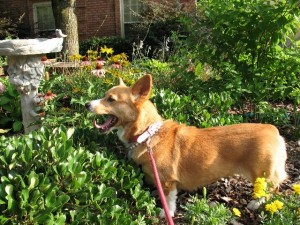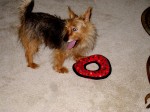
Sometimes dogs seem to leak urine. I’ve noticed that it occurs more often during initial greetings. This can be caused by youth, a developmental problem, a medical condition, a behavioral issue or a combination of factors. It’s always possible that sudden urination is the result of both behavioral and non-behavioral causes.
Contributors such as underdeveloped organs, medications that facilitate poor bladder control, diseases, or failures of organs are examples of non-behavioral causes.
Before you can address involuntary urination from a behavioral point of view, it’s essential to ask your veterinarian to perform a thorough medical check-up to rule out non-behavioral reasons for the urination.
Once you’ve ruled out all non-behavioral causes, determine if the urination is submissive urination, or excitement urination, or both.
Observe your dog’s body language. Carefully notice ear, head, tail position, and overall body language at the instant of urination.
Common submissive behaviors include lowered ears, lowered head and body, and a tucked tail.
If the dog is not walking or running, (the instant urination begins), the urination is most likely to be submissive in nature. If the dog is standing, sitting or lying, the urination is submissive. If the dog is in the process of sitting or lying, or rolling over, it’s submissive urination.
Take note of your interactions with the dog. If the dog urinates when you bend over or reach towards him or her, it’s submissive urination.
If the dog urinates when you interact via speech, touch or eye contact, it’s more likely to be submissive urination.
If the dog is not sitting or lying, and is not in the process of sitting or lying, AND you are not interacting with the dog, it is more likely to be excitement urination. If he or she eliminates while running to greet you, it is more likely to be excitement urination. If the dog urinates while zooming around the room, it’s excitement urination.
I’ve only met a few dogs that exhibited excitement urination. Most often, submissive urination is the diagnosis. In rare cases, it is a combination of both submissive and excitement urination.
Excitement Urination Solutions
Be sure to have your vet rule out medical causes if you have an older dog that exhibits excitement urination.
To reduce excitement urination, tone down your enthusiasm. Avoid games that involve excessive amounts of glee which encourage your dog to race around the room. More often than not, a pup with excitement urination will grow out of the behavior after he’s been with you a while. Some older dogs may always release urine
when encouraged to dash around the house.
Submissive Urination Solutions
Shy dogs are prone to exhibit submissive urination. Confident dogs are less likely to react with submission when people interact with them. Submissive urination is not a voluntary behavior; it is triggered by “scary” stimuli and is more of a fear response. After the family learns a bit about the causes and changes their behaviors, and the dog matures and gains confidence, it usually subsides. Here are some short term and long term suggestions.
Short Term Solutions
Make your approaches less intimidating. During initial greetings, turn sideways. Avoid bending over to greet the dog. Don’t reach to pat the dog, especially on top of the head. Don’t initially speak to the dog, and don’t make eye contact.
After a few minutes, greet the dog in a calm, non-threatening manner. Touching a dog on the chest or belly so that your arm or hand does not loom over the dog’s head or body is usually perceived as less threatening. Patting a dog’s hips, back or sides, and scratching behind the ears, are less threatening when you are beside and slightly behind the dog as opposed to positioning yourself directly in front.
Never fuss at a dog or console the dog for submissive urination. Act as if it did not happen.
If you expect guests, take your pup outside on a leash for the initial greeting. This won’t solve the problem, but it will make cleanup unnecessary!
If your dog jumps up on guests and then releases urine when the guests reach to pet him or her, your goal is to teach your dog how to greet politely.
If the dog eliminates when released from a crate, place the crate near an outside exit into a fenced area. Before you open the crate, open the outside door. Then open the crate door, and without saying anything, step outside and call the dog or toss a toy outside. If your dog is small and is confined in an airline carrier, pick up the carrier and take it outside before you open the carrier door and walk away.
Teach the dog to perform an alternate, confident behavior that will focus attention on something other than the approach of people. Ask for this alternate behavior when you or others approach. Fetch, chase the ball, or “parade with toy in mouth” are good choices for alternate behaviors.
During this treatment period, always greet the dog with a couple of toys in hand. Place them outside the door in the garage or utility room. During the greeting (before the dog reaches you), toss a ball for him or her to chase/retrieve. This will physically orient the dog away from you and focus his or her attention on a task that is incompatible with submissive greetings.
Instead of using toys, you could toss a few tasty food treats on the floor. Toss them in an area behind or to the side of the dog. This focuses the dog’s attention away from you. Walk back out the door while the dog is eating the treats. Repeat this sequence two times whenever you arrive home. After your second entrance, toss the treats and walk into another room and be seated. Wait for the dog to approach you. You may speak softly to the dog, but do not reach out to touch the dog. Wait a couple of minutes before you start interacting.
After a few of these sessions, your dog will begin to associate your arrival with food treats. The involuntary submissive responses to the stimulus of approaching humans will be replaced with the involuntary response of salivation. Your approach will trigger a “Oh goodie, here come the treats!” response.
Long Term Solutions
Your methods of interacting throughout the day shape the relationship with your puppy. Following these guidelines will usually reduce submissive urination due to behavioral causes.
- Do not scold your pup or use body language which triggers submissive urination.
- Never scold any dog for any house training mistakes, much less for submissive urination.
- Do not coddle or tell your submissive dog, “it’s ok”. Just ignore the behavior and try to engage the dog in a confident task.
- Never reach down and touch any dog that is jumping up to greet you.
- Careful socialization in safe environments during the critical period of socialization (3-12 weeks) may lower the risk of submissive urination.
- Meet the dog’s physical, social and emotional needs.
- Treating other fearful behaviors may reduce the instances of submissive urination.
- Soften your voice when giving commands.
- If your primary choice for teaching involves leash jerks, shouting ‘no”, corrections with a training collar, et cetera, discontinue these corrections-based teaching methods.
- Start a training program based on consistency, a clear communication system and a reward system. In addition to basic obedience commands, teach your dog some tricks / skills / commands that will engage him or her to perform confident actions. I already mentioned fetch, chase the ball and parade with toy; spin and find the “xyz” are other examples of confident behaviors.
- Touch or target training can increase a dogs’ confidence. Teach your dog to touch your two-finger target for a treat. After confidence builds, introduce “shake” or “high five”.
- Enrich your dog’s environment. Scatter feed. Toss kibble on the patio or on the kitchen floor. Encourage your dog to hunt for each piece.
- Each person in the household should teach and exercise the dog.
- Review the quality of your dog’s diet.
- Begin a massage program.
If your dog continues to leak urine, ask your veterinarian for the name of a trainer or visit http://apdt.com and search for a trainer in your area.
 I have these dog goodies linked on this site so my clients can find the best items at the best prices! I mention many of these items during group and private dog training sessions.
I have these dog goodies linked on this site so my clients can find the best items at the best prices! I mention many of these items during group and private dog training sessions. 




